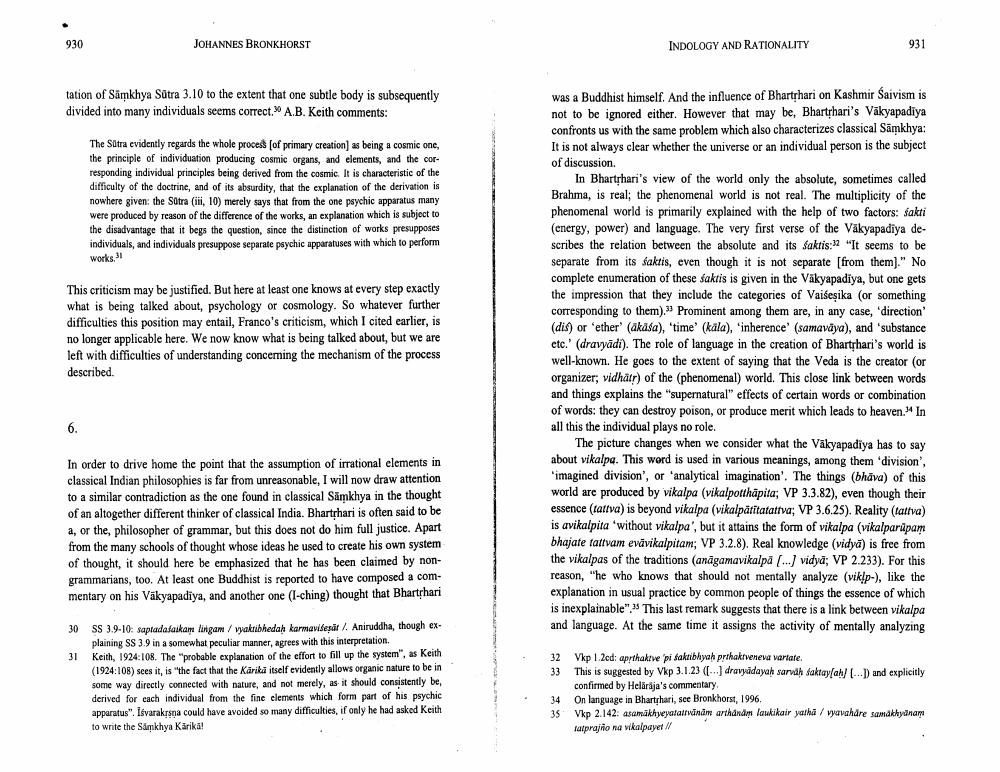Book Title: Indology And Rationality Author(s): Johannes Bronkhorst Publisher: Johannes Bronkhorst View full book textPage 8
________________ 930 JOHANNES BRONKHORST INDOLOGY AND RATIONALITY 931 tation of Samkhya Sütra 3.10 to the extent that one subtle body is subsequently divided into many individuals seems correct. A.B. Keith comments: The Sotra evidently regards the whole process of primary creation) as being a cosmic one, the principle of individuation producing cosmic organs, and elements, and the corresponding individual principles being derived from the cosmic. It is characteristic of the difficulty of the doctrine, and of its absurdity, that the explanation of the derivation is nowhere given the Satra (iii, 10) merely says that from the one psychic apparatus many were produced by reason of the difference of the works, an explanation which is subject to the disadvantage that it begs the question, since the distinction of works presupposes individuals, and individuals presuppose separate psychic apparatuses with which to perform works. 31 This criticism may be justified. But here at least one knows at every step exactly what is being talked about, psychology or cosmology. So whatever further difficulties this position may entail, Franco's criticism, which I cited earlier, is no longer applicable here. We now know what is being talked about, but we are left with difficulties of understanding concerning the mechanism of the process described. was a Buddhist himself. And the influence of Bharthari on Kashmir Saivism is not to be ignored either. However that may be, Bharthari's Väkyapadiya confronts us with the same problem which also characterizes classical Samkhya: It is not always clear whether the universe or an individual person is the subject of discussion In Bharthari's view of the world only the absolute, sometimes called Brahma, is real; the phenomenal world is not real. The multiplicity of the phenomenal world is primarily explained with the help of two factors: sakti (energy, power) and language. The very first verse of the Vakyapadiya describes the relation between the absolute and its faktis: 2 "It seems to be separate from its faktis, even though it is not separate (from them)." No complete enumeration of these faktis is given in the Väkyapadiya, but one gets the impression that they include the categories of Vaišeşika (or something corresponding to them)." Prominent among them are, in any case, direction (dis) or 'ether' (akáša), 'time' (kala), inherence' (samaväya), and 'substance etc.' (dravyādi). The role of language in the creation of Bharthari's world is well-known. He goes to the extent of saying that the Veda is the creator (or organizer, vidhäir) of the (phenomenal) world. This close link between words and things explains the "supernatural" effects of certain words or combination of words: they can destroy poison, or produce merit which leads to heaven. In all this the individual plays no role. The picture changes when we consider what the Vakyapadiya has to say about vikalpa. This word is used in various meanings, among them division, 'imagined division', or 'analytical imagination. The things (bhava) of this world are produced by vikalpa (vikalpotthāpita; VP 3.3.82), even though their essence (tattva) is beyond vikalpa (vikalpätitatattva; VP 3.6.25). Reality (tattva) is avikalpita'without vikalpa', but it attains the form of vikalpa (vikalparūpam bhajate tattvam evävikalpitam; VP 3.2.8). Real knowledge (vidyā) is free from the vikalpas of the traditions (anāgamavikalpa (...) vidya; VP 2.233). For this reason, "he who knows that should not mentally analyze (viklp.), like the explanation in usual practice by common people of things the essence of which is inexplainable". This last remark suggests that there is a link between vikalpa and language. At the same time it assigns the activity of mentally analyzing In order to drive home the point that the assumption of irrational elements in classical Indian philosophies is far from unreasonable, I will now draw attention to a similar contradiction as the one found in classical Samkhya in the thought of an altogether different thinker of classical India. Bharthari is often said to be a, or the philosopher of grammar, but this does not do him full justice. Apart from the many schools of thought whose ideas he used to create his own system of thought, it should here be emphasized that he has been claimed by nongrammarians, too. At least one Buddhist is reported to have composed a commentary on his Väkyapadiya, and another one (I-ching) thought that Bharthari 30 31 . SS 3.9-10. saptada laikam lingam / wakubhedah karmavidesdir / Aniruddha, though ex. plaining SS 3.9 in a somewhat peculiar manner, agrees with this interpretation Keith, 1924:108. The probable explanation of the effort to fill up the system", as Keith (1924:108) sces it, is the fact that the Kärikä itself evidently allows organic nature to be in some way directly connected with nature, and not merely, as it should consistently be, derived for each individual from the fine elements which form part of his psychic apparatus". Isvarakrsna could have avoided so many difficulties, if only he had asked Keith to write the Samkhya Karikā! 32 33 Vkp 12cd: apythakive 'pi faktibhiyah prihakiveneva variate. This is suggested by Vkp 3.1.23 ((...) dravādayah sarvah saktayan [...]) and explicitly confirmed by Heläraja's commentary On language in Bharthari, see Bronkhorst, 1996. Vkp 2.142: asamākhyeyatarwnām arthandm laukikair yatha / vyavahdre samakhyanam atprario na vikalpayet il 34 35Page Navigation
1 ... 6 7 8 9 10 11 12 13
